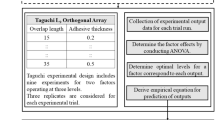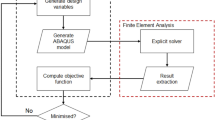Abstract
Adhesive bonded joints are one of important joining technologies in supporting various manufacturing applications. It is important to predict the optimal strength of adhesive bonded joints in order to fit design requirements. Prediction on joint strengths is usually based on experimental tests and Finite Element Analysis (FEA). However, it is a time-consuming and expensive process. To improve computational efficiency and reduce experimental cost, in this chapter, a new approach based on a machine learning algorithm and a FEA method is proposed to predict the failure loads of joints. The innovations of the approach include the following aspects: (1) the FEA model for analyzing the strengths of joints is validated using experimental tests to generate a robust dataset for training a Deep Neural Networks (DNNs) algorithm, which is designed to predict the failure loads of various joint material combinations with high efficiency; (2) based on the trained DNNs algorithm, a Fruit Fly Algorithm (FFO) is proposed to identify the optimal material parameters of Adhesive bonded joints in a given geometry and an joint configuration. The proposed FEA method was successfully validated by conducting experiments with samples of single lap joints. 375 samples were generated by the validated FEA model for DNNs’ training, validation and testing. Case studies showed that the computational time of this approach was saved by 99.54% compared with that of the FEA model, and optimal parameters were identified within 9 iterations based on the proposed FFO optimization algorithm.
Access this chapter
Tax calculation will be finalised at checkout
Purchases are for personal use only
Similar content being viewed by others
References
Cheng F, Hu Y, Lv Z, Chen G, Yuan B, Hu X, Huang Z (2020) Directing helical CNT into chemically-etched micro-channels on aluminium substrate for strong adhesive bonding with carbon fiber composites. Compos Part A: Appl Sci Manufact 135:105952
Shi J, Cao W, Wu Z (2019) Effect of adhesive properties on the bond behaviour of externally bonded FRP-to-concrete joints. Compos B Eng 177:107365
Capuano G, Rimoli J (2019) Smart finite elements: A novel machine learning application. Comput Methods Appl Mech Eng 345:363–381
Ojalvo I, Eidinoff H (1978) Bond Thickness Effects upon Stresses in Single-Lap Adhesive Joints. AIAA J 16(3):204–211
Carbas R, da Silva L, Madureira M, Critchlow G (2014) Modelling of functionally graded adhesive joints. J Adhesion 90(8):698–716
Stein N, Mardani H, Becker W (2016) An efficient analysis model for functionally graded adhesive single lap joints. Int J Adhes Adhes 70:117–125
Stein N, Weißgraeber P, Becker W (2016) Stress solution for functionally graded adhesive joints. Int J Solids Struct 97–98:300–311
Bahrami B, Ayatollahi M, Beigrezaee M, da Silva L (2019) Strength improvement in single lap adhesive joints by notching the adherends. Int J Adhes Adhes 95:102401
Sadeghi M, Gabener A, Zimmermann J, Saravana K, Weiland J, Reisgen U, Schroeder K (2020) Failure load prediction of adhesively bonded single lap joints by using various FEM XE “FEM” techniques. Int J Adhes Adhes 97:102493
Saleh M, Saeedifar M, Zarouchas D, De Freitas S (2020) Stress analysis of double-lap bi-material joints bonded with thick adhesive. Int J Adhes Adhes 97:102480
Ramalho L, Campilho R, Belinha J (2020) Single lap joint strength prediction using the radial point interpolation method and the critical longitudinal strain criterion. Eng Anal Boundary Elem 113:268–276
Chou J, Tsai C, Pham A, Lu Y (2014) Machine learning in concrete strength simulations: Multi-nation data analytics. Constr Build Mater 73:771–780
Zhu J, Zhang W (2018) Probabilistic fatigue damage assessment of coastal slender bridges under coupled dynamic loads. Eng Struct 166:274–285
Saadallah A, Finkeldey F, Morik K, Wiederkehr P (2018) Stability prediction in milling processes using a simulation-based Machine Learning approach. Procedia CIRP 72:1493–1498
Al-Shamiri A, Kim J, Yuan T, Yoon Y (2019) Modeling the compressive strength of high-strength concrete: An extreme learning approach. Constr Build Mater 208:204–219
Putra G, Kitamura M, Takezawa A (2019) Structural optimization of stiffener layout for stiffened plate using hybrid GA XE “Genetic Algorithm (GA)” . Int J Naval Architecture Ocean Eng 11(2):809–818
Wu C, Fang J, Li Q (2019) Multi-material topology optimization for thermal buckling criteria. Comput Methods Appl Mech Eng 346:1136–1155
Chegini S, Bagheri A, Najafi F (2018) PSO XE “PSO” SCALF: A new hybrid PSO based on Sine Cosine Algorithm and Levy flight for solving optimization problems. Appl Soft Comput 73:697–726
Tsiptsis I, Liimatainen L, Kotnik T, Niiranen J (2019) Structural optimization employing isogeometric tools in Particle Swarm Optimizer. J Build Eng 24:100761
Huntsman (2015) Araldite 2015 technical data sheet. https://krayden.com/technical-data-sheet/huntsman-araldite-2015-tds. Accessed 21 Oct 2020
Sika Company (2009) Sika Primer-204 N. https://gbr.liquidplastics.sika.com/en/sika-liquid-plastics/liquid-roof-waterproofing-accessories/primers/sika-primer-204-n.html. Accessed 21 Oct 2020
Campilho R, Banea M, Neto J, da Silva L (2013) Modelling adhesive joints with cohesive zone models: effect of the cohesive law shape of the adhesive layer. Int J Adhes Adhes 44:48–56
Cabrera D, Guamán A, Zhang S, Cerrada M, Sánchez R, Cevallos J, Long J, Li C (2020) Bayesian approach and time series dimensionality reduction to LSTM XE “LSTM” -based model-building for fault diagnosis of a reciprocating compressor. Neurocomputing 380:51–66
Liang Y., Li W., Lu X., Wang S., 2019. Fog computing and convolutional neural network enabled prognosis for machining process optimization. Journal of Manufacturing Systems. 52: 32–42.
Mammone N, Ieracitano C, Morabito F (2020) A deep CNN XE “CNN” approach to decode motor preparation of upper limbs from time–frequency maps of EEG signals at source level. Neural Netw 124:357–372
Liang YC, Lu X, Li WD, Wang S (2018) Cyber physical system and big data enabled energy efficient machining optimisation. J Clean Product 187:46–62
Ou G, Murphey Y (2007) Multi-class pattern classification using neural networks. Pattern Recogn 40(1):4–18
He K, Sun J (2015) Convolutional neural networks at constrained time cost. Proceedings of the 2015 IEEE Conference on computer vision and pattern recognition (CVPR)
Sak H, Senior A, Beaufays F (2014) Long short-term memory based recurrent neural network architectures for large vocabulary speech recognition. Available at arXiv:1402.1128
Fei X, Shah N, Verba N, Chao K, Sanchez-Anguix V, Lewandowski J, James A, Usman Z (2019) CPS data streams analytics based on machine learning for cloud and fog computing: A survey. Fut Gen Comput Syste 90:435–450
Yarotsky D (2017) Error bounds for approximations with deep ReLU networks. Neural Netw 94:103–114
Pan W (2012) A new fruit fly optimization algorithm: Taking the financial distress model as an example. Knowl-Based Syst 26:69–74
Author information
Authors and Affiliations
Corresponding author
Editor information
Editors and Affiliations
Rights and permissions
Copyright information
© 2021 The Author(s), under exclusive license to Springer Nature Switzerland AG
About this chapter
Cite this chapter
Liang, Y.C., Liu, Y.D., Li, W.D. (2021). Prediction of Strength of Adhesive Bonded Joints Based on Machine Learning Algorithm and Finite Element Analysis. In: Li, W., Liang, Y., Wang, S. (eds) Data Driven Smart Manufacturing Technologies and Applications. Springer Series in Advanced Manufacturing. Springer, Cham. https://doi.org/10.1007/978-3-030-66849-5_8
Download citation
DOI: https://doi.org/10.1007/978-3-030-66849-5_8
Published:
Publisher Name: Springer, Cham
Print ISBN: 978-3-030-66848-8
Online ISBN: 978-3-030-66849-5
eBook Packages: EngineeringEngineering (R0)




